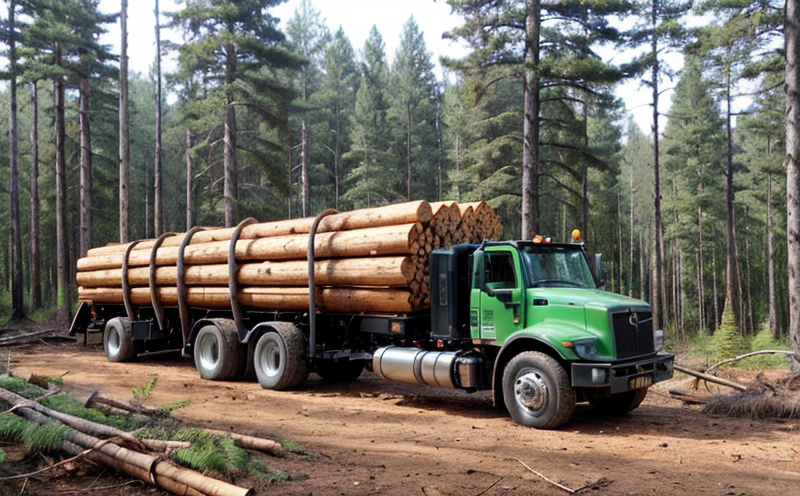Timber Modulus of Rupture Testing
The modulus of rupture (MOR), also known as flexural strength or bend strength, is a measure of how much bending stress a timber specimen can withstand before it breaks. This property is critical in the construction and engineering sectors, particularly for forestry products like beams, joists, and other structural components used in buildings.
Testing for MOR involves subjecting a sample to a controlled load until failure occurs. The strength at which the specimen fails is recorded as the modulus of rupture. Understanding this property helps engineers design safer structures by ensuring that materials can withstand the expected loads without failing under service conditions.
In forestry, MOR testing provides crucial insights into the quality and suitability of different types of wood for structural applications. It aids in selecting appropriate timber species based on their mechanical properties, which are key determinants in construction projects.
The test method typically follows international standards such as ISO 14683:2019 or ASTM D790-18. These guidelines specify the dimensions of specimens to be used, the testing apparatus required, and the procedure for conducting the test accurately. Specimens are usually rectangular prisms with dimensions specified in these standards.
Proper specimen preparation is essential; it includes ensuring uniform moisture content, trimming the edges to precise dimensions, and making sure that the surface of the specimen is smooth and free from defects. The testing machine used should be capable of applying a known load at a controlled rate until failure occurs.
The results obtained from MOR tests are presented in terms of force per unit area (MPa). These values help determine which timber types have the best structural integrity for specific applications, thereby facilitating informed decision-making by architects, engineers, and foresters.
For instance, higher MOR indicates greater resistance to bending stresses, making it more suitable for load-bearing structures. Conversely, lower MOR might suggest less robust performance under similar conditions, necessitating careful consideration when specifying timber types in construction projects.
Understanding the modulus of rupture is also vital for quality control and compliance purposes. It ensures that materials meet specified standards, which is crucial for maintaining safety and reliability across various industries relying heavily on wood products.
Eurolab Advantages
- State-of-the-art equipment ensuring accurate results.
- Experienced technicians with specialized knowledge in forestry testing.
- Comprehensive range of services tailored to your specific needs.
- Prompt turnaround times for timely project completion.
At Eurolab, we pride ourselves on delivering reliable and accurate results every time. Our team utilizes advanced instrumentation that adheres strictly to international standards, ensuring precision in all our tests. With years of experience behind us, our technicians bring expertise that guarantees consistent quality across each test performed.
We understand the importance of timely delivery; therefore, we strive to complete your MOR testing quickly so you can proceed with your project without unnecessary delays. Whether it's for research and development (R&D), compliance checks, or routine inspections, Eurolab offers a full spectrum of forestry product testing services designed specifically to meet your requirements.
International Acceptance and Recognition
- ISO 14683:2019 is widely recognized globally for its rigorous approach to MOR testing in wood products.
- ASTM D790-18 sets standards that are accepted worldwide by numerous industries.
The modulus of rupture test falls under the broader category of mechanical property tests conducted on forestry products. These internationally accepted methods provide a standardized framework for comparing different types of wood based on their bending strength, enabling consistent quality across borders and international projects.
By adhering to these recognized standards, Eurolab ensures that all our testing results are comparable with those from other reputable laboratories around the world. This consistency is vital when dealing with global supply chains or multinational projects where uniformity in material specifications is required.
Use Cases and Application Examples
| Application Example | Description |
|---|---|
| Structural Design | Determining the appropriate wood type for beams, joists, and other load-bearing components. |
| Quality Control | Evaluating compliance with regulatory standards to ensure safety. |
| New Product Development | Optimizing product design by selecting the most suitable wood species based on MOR data. |
| Forestry Research | Investigating variations in wood properties due to different growing conditions or genetic factors. |
| Procurement | Selecting suppliers who consistently provide high-quality timber products. |
| Environmental Impact Assessment | Evaluating the sustainability of wood sourcing practices. |
| Regulatory Compliance | Ensuring that all forestry products meet local and international regulations regarding strength and durability. |
The modulus of rupture test plays a pivotal role in various applications within the forestry sector. From ensuring structural integrity during construction to supporting environmental assessments, this property is essential for making informed decisions about timber usage. By leveraging MOR testing results, stakeholders can enhance safety and sustainability while meeting regulatory requirements.





